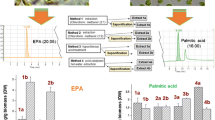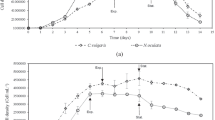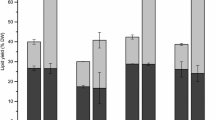Abstract
Microalgae when subjected to nutrient restriction conditions, inducing environmental stress, are prone to total lipid accumulation and changes in the fatty profile. In this context, the green microalgae Chlamydomonas sp. was submitted for 3 days to the absence of nutrients. Thus, the efficacy of the extraction of the crude hexane lipid fraction (CHF), using mechanical stirred associated with ultrasound technique, was evaluated in two different times (2 and 4 h), using scanning electron microscopy and thermogravimetric analysis (TG). Saponifiable fractions, CHF extracts and crude chloroform fraction (CCF) were esterified and characterized by TG, FTIR and GC/MS to identify their fatty profile. Residual biomass (RB) was analyzed by elemental analysis, and the resulting data were employed to estimate the higher heating value (HHV) and crude protein percentage. The micrographs of the biomass surfaces before and after the extraction process showed significant fragmentation only for the time of 4 h. A pronounced mass loss in the typical lipid range was evidenced by TG being consistent with the significant difference of material extracted in the time of 2 h (2.95 ± 0.28)% and 4 h (10.54 ± 0.46)%. The total lipid fraction (CHF and CCF) was approximately 29%. The RB revealed values of HHV and crude protein of 18 MJ kg−1 and 56%, respectively. The TG data for the CCF extract revealed a material consisting mainly of saponifiable fractions, unlike CHF which is composed predominantly of unsaponifiables. Therefore, the TG curve ratified a better conversion rate to CCF (approximately 89%), consistent with the value obtained by GC/MS (about 86%). The fatty profile for the saponifiable fractions of both extracts showed that the major fatty acids are C16:0 and C18:3 (ω-3 and ω-6). The ester profile with elevated concentration of polyunsaturated fatty acids (C18:3) is unfeasible in their application for biodiesel production; nevertheless, the fatty profile of microalgae suggests pharmacological potential for diet or therapy, since some of the main components are reported as bioactive metabolites.






Similar content being viewed by others
References
Morioca C. Floculação de Chlorella sp. produzida em concentrado de dessalinização e estudo de método de extração de lipídeos intracelulares. Quími Nova. 2014. https://doi.org/10.1590/s0100-40422014000100009.
Markou G, Nerantzis E. Microalgae for high-value compounds and biofuels production: a review with focus on cultivation under stress conditions. Biotechnol Adv. 2013. https://doi.org/10.1016/j.biotechadv.2013.07.011.
Trivedi J, Aila M, Bangwal DP, Kaul S, Garg MO. Algae based biorefinery—how to make sense? Renew Sustain Energy Rev. 2015. https://doi.org/10.1016/j.rser.2015.03.052.
Ahmad AL, Yasin NHM, Derek JK, Lim K. Microalgae as a sustainable energy source for biodiesel production: a review. Renew Sustain Energy Rev. 2011. https://doi.org/10.1016/j.rser.2010.09.018.
Pereira CMP, Hobuss CB, Maciel JV, Ferreira LR, Del Pino FB, Mesko MF, Jacob LE, Neto PC. Biodiesel renovável derivado de microalgas: avanços e perspectivas tecnológicas. Quími Nova. 2012. https://doi.org/10.1590/s0100-40422012001000022.
Abdul RWAKG, Wan AYH, Taufiq Y, Michael KD, Razif H. Thermochemical conversion of microalgal biomass for biofuel production. Renew Sustain Energy Rev. 2015. https://doi.org/10.1016/j.rser.2015.04.186.
Nakanishi A, Aikawa S, Ho S, Chen C, Chang J, Hasunuma T, Kondo A. Development of lipid productivities under different CO2 conditions of marine microalgae Chlamydomonas sp. JSC4. Bioresour Technol. 2014. https://doi.org/10.1016/j.biortech.2013.11.009.
Kato Y, Ho S, Vavricka CJ, Chang JS, Hasunuma T, Kondo A. Evolutionary engineering of salt-resistant Chlamydomonas sp. strains reveals salinity stress-activated starch-to-lipid biosynthesis switching. Bioresour Technol. 2017. https://doi.org/10.1016/j.biortech.2017.06.035.
Magali S, Stéphan C, Caroline C, Boris F, Mai N, Patrick C, Audrey B, Fred B, Christian T, Yonghua L, Gilles P. Oil accumulation in the model green alga Chlamydomonas reinhardtii: characterization, variability between common laboratory strains and relationship with starch reserves. BMC Biotechnol. 2011. https://doi.org/10.1186/1472-6750-11-7.
Zhu L. The combined production of ethanol and biogas from microalgal residuals to sustain microalgal biodiesel: a theoretical evaluation. Biofuels Bioprod Biorefining. 2014. https://doi.org/10.1002/bbb.1442.
Zhu L. Biorefinery as a promising approach to promote microalgae industry: an innovative framework. Renew Sustain Energy Rev. 2015. https://doi.org/10.1016/j.rser.2014.09.040.
Chernova NI, Kiseleva SV. Microalgae biofuels: induction of lipid synthesis for biodiesel production and biomass residues into hydrogen conversion. Int J Hydrogen Energy. 2017. https://doi.org/10.1016/j.ijhydene.2016.05.302.
Demirbas A. Biomass resource facilities and biomass conversion processing for fuels and chemicals. Energy Convers Manag. 2001. https://doi.org/10.1016/s0196-8904(00)00137-0.
Nobre BP, Villalobos F, Barragán BE, Oliveira AC, Batista AP, Marques PASS, Mendes RL, Sovová H, Palavra AF, Gouveia L. A biorefinery from Nannochloropsis sp microalga—Extraction of oils and pigments Production of biohydrogen from the leftover biomass. Bioresour Technol. 2013. https://doi.org/10.1016/j.biortech.2012.11.084.
Subhadra B, Grinson G. Algal biorefinery-based industry: an approach to address fuel and food insecurity for a car-bon-smart world. J Sci Food Agric. 2011. https://doi.org/10.1002/jsfa.4207.
Vanthoor-Koopmans M, Wijffels RH, Barbosa MJ, Eppink MHM. Biorefinery of microalgae for food and fuel. Bioresour Technol. 2013. https://doi.org/10.1016/j.biortech.2012.10.135.
Service RF. Algae’s second try. Science. 2011. https://doi.org/10.1126/science.333.6047.1238.
Araujo GS, Matos LJBL, Fernandes JO, Cartaxo SJM, Gonçalves LRB, Fernandes FAN, Farias WRL. Extraction of lipids from microalgae by ultrasound application: prospection of the optimal extraction method. Ultrason Sonochem. 2013. https://doi.org/10.1016/j.ultsonch.2012.07.027.
Lee J, Yoo C, Jun SY, Ahn C, Oh H. Comparison of several methods for effective lipid extraction from microalgae. Bioresour Technol. 2010. https://doi.org/10.1016/j.biortech.2009.03.058.
Gomes AF. Extração e análise da fração lipídica da microalga Monoraphidium sp., síntese e caracterização do seu biodiesel. Dissertação de Mestrado, Universidade Federal do Rio Grande do Norte, Brasil. 2013. https://repositorio.ufrn.br/jspui/bitstream/123456789/17702/1/AndersonFG_DISSERT.pdf. Accessed 15 oct 2018.
Bigogno C, Khozin-Goldberg I, Boussiba S, Vonshak A, Cohen Z. Lipid and fatty acid composition of the green oleaginous alga Parietochloris incisa, the richest plant source of arachidonic acid. Phytochemistry. 2002. https://doi.org/10.1016/s0031-9422(02)00100-0.
Ferruzzi MG, Blakeslee J. Digestion, absorption, and cancer preventative activity of dietary chlorophyll derivatives. Nutr Res. 2007. https://doi.org/10.1016/j.nutres.2006.12.003.
Chew KW, Yap JY, Show PL, Suan HN, Juan JC, Ling TC, Lee DJ, Chang JS. Microalgae biorefinery: high value products perspectives. Bioresour Technol. 2017. https://doi.org/10.1016/j.biortech.2017.01.006.
Demirbas A. Oily products from mosses and algae via pyrolysis. Energ Source Part A. 2007. https://doi.org/10.1080/009083190910389.
Zhao Z, Liu P, Wang S, Ma S, Cao J. Combustion characteristics and kinetics of five tropic oilgal strains using thermogravimetric analysis. J Therm Anal Calorim. 2018. https://doi.org/10.1007/s10973-017-6646-0.
Paniagua S, Calvo LF, Escapa C, Coimbra RN, Otero M, García AI. Chlorella sorokiniana thermogravimetric analysis and combustion characteristic indexes estimation. J Therm Anal Calorim. 2018. https://doi.org/10.1007/s10973-017-6734-1.
Brown MR, Jeffrey SW, Volkman JK, Dunstan GA. Nutritional properties of microalgae for mariculture. Aquaculture. 1997. https://doi.org/10.1016/s0044-8486(96)01501-3.
Chuntapa B, Powtongsook S, Menasveta P. Water quality control using Spirulina platensis in shrimp culture tanks. Aquaculture. 2003. https://doi.org/10.1016/s0044-8486(02)00428-3.
Friedl A, Padouvas E, Rotter H, Varmuza K. Prediction of heating values of biomass fuel from elemental composition. Anal Chim Acta. 2005. https://doi.org/10.1016/j.aca.2005.01.041.
Becker EW. Microalgae: biotechnology and microbiology. Cambridge: Cambridge University Press; 1994.
Toma M, Vinatoru M, Paniwnyk L, Mason TJ. Investigation of the effects of ultrasound on vegetal tissues during solvent extraction. Ultrason Sonochem. 2001. https://doi.org/10.1016/s1350-4177(00)00033-x.
Jaouen P, Vandanjon L, Quéméneur F. The shear stress of microalgal cell suspensions (Tetraselmis suecica) in tangential flow filtration systems: the role of pumps. Bioresour Technol. 1999. https://doi.org/10.1016/s0960-8524(98)00144-8.
Conney M, Young G, Nagle N. Extraction of bio-oils from microalgae. Sep Purif Rev. 2009. https://doi.org/10.1080/15422110903327919.
Shirsath SR, Sonawane SH, Gogate PR. Intensification of extraction of natural products using ultrasonic irradiations—A review of current status. Chem Eng Process. 2012. https://doi.org/10.1016/j.cep.2012.01.003.
Yang L, Chen J, Qin S, Zeng M, Jiang Y, Hu L, Wang J. Growth and lipid accumulation by different nutrients in the microalga Chlamydomonas reinhardtii. Biotechnol Biofuels. 2018. https://doi.org/10.1186/s13068-018-1041-z.
Converti A, Casazza AA, Ortiz EY, Perego P, Borghi MD. Effect of temperature and nitrogen concentration on the growth and lipid content of Nannochloropsis oculata and Chlorella vulgaris for biodiesel production. Chem Eng Process. 2009. https://doi.org/10.1016/j.cep.2009.03.006.
Mujtaba G, Choi W, Lee CG, Lee K. Lipid production by Chlorella vulgaris after a shift from nutrient-rich to nitrogen starvation conditions. Bioresour Technol. 2012. https://doi.org/10.1016/j.biortech.2012.07.057.
Simionato D, Block MA, La Rocca N, Jouhet J, Maréchal E, Finazzi G, Morosinotto T. The response of Nannochloropsis gaditana to nitrogen starvation includes de novo biosynthesis of triacylglycerols, a decrease of chloroplast galactolipids, and reorganization of the photosynthetic apparatus. Eukaryot Cell. 2013. https://doi.org/10.1128/ec.00363-12.
Courchesne NMD, Parisien A, Wang B, Lan CQ. Enhancement of lipid production using biochemical, genetic and transcription factor engineering approaches. J Biotechnol. 2009. https://doi.org/10.1016/j.jbiotec.2009.02.018.
Feng P, Deng Z, Fan L, Hu Z. Lipid accumulation and growth characteristics of Chlorella zofingiensis under different nitrate and phosphate concentrations. J Biosci Bioeng. 2012. https://doi.org/10.1016/j.jbiosc.2012.05.007.
Ansari FA, Gupta SK, Nasr M, Rawat I, Bux F. Evaluation of various cell drying and disruption techniques for sustainable metabolite extractions from microalgae grown in wastewater: a multivariate approach. J Clean Prod. 2018. https://doi.org/10.1016/j.jclepro.2018.02.098.
Pohndorf RS, Camara AS, Larrosa APQ, Pinheiro CP, Strieder MM, Pinto LAA. Production of lipids from microalgae Spirulina sp: influence of drying, cell disruption and extraction methods. Biomass Bioenergy. 2016. https://doi.org/10.1016/j.biombioe.2016.06.020.
Luque R, Herrero-Davila L, Campelo JM, Clark JH, Hidalgo JM, Luna D, et al. Biofuels: a technological perspective. Energy Environ Sci. 2008. https://doi.org/10.1039/b807094f.
Shekh AY, Shrivastava P, Krishnamurthi K, Mudliar SN, Saravana Devi S, Kanade GS, Chakrabarti T. Stress enhances poly-unsaturation rich lipid accumulation in Chlorella sp. and Chlamydomonas sp. Biomass Bioenergy. 2016. https://doi.org/10.1016/j.biombioe.2015.11.013.
Amoah J, Ho SH, Hama S, Yoshida A, Nakanishi A, Hasunuma T, Ogino C, Kondo A. Conversion of Chlamydomonas sp JSC4 lipids to biodiesel using Fusarium heterosporum lipase-expressing Aspergillus oryzae whole-cell as biocatalyst. Algal Res. 2017. https://doi.org/10.1016/j.algal.2017.10.003.
Fu L, Cui X, Li Y, Xu L, Zhang C, Xiong R, Zhou D, Crittenden JC. Excessive phosphorus enhances Chlorella regularis lipid production under nitrogen starvation stress during glucose heterotrophic cultivation. Chem Eng J. 2017. https://doi.org/10.1016/j.cej.2017.07.182.
Chen W, Huang M, Chang J, Chen C. Thermal decomposition dynamics and severity of microalgae residues in torrefaction. Bioresour Technol. 2014. https://doi.org/10.1016/j.biortech.2014.06.086.
Campanella A, Muncrief R, Harold MP, Griffith DC, Whitton NM, Weber RS. Thermolysis of microalgae and duckweed in a CO2-swept fixed-bed reactor: bio-oil yield and compositional effects. Bioresour Technol. 2012. https://doi.org/10.1016/j.biortech.2011.12.115.
Garcia CC, Franco PIBM, Zuppa TO, Antoniosi Filho NR, Leles MIG. Thermal stability studies of some cerrado plant oils. J Therm Anal Calorim. 2007. https://doi.org/10.1007/s10973-006-7769-x.
Gomes AF, Gomes MPS, Souza DL, Costa M. Thermal and chromatographic characterization of biomass, lipid material, and microalgal biodiesel from Monoraphidium sp. J Therm Anal Calorim. 2015. https://doi.org/10.1007/s10973-014-43475.
Chand P, Reddy V, Verkade JG, Wang T, Grewell D. Thermogravimetric quantification of biodiesel produced via alkali catalyzed transesterification of soybean oil. Energy Fuels. 2009. https://doi.org/10.1021/ef800668u.
Anand J, Arumugam M. Enhanced lipid accumulation and biomass yield of Scenedesmus quadricauda under nitrogen starved condit ion. Bioresour Technol. 2015. https://doi.org/10.1016/j.biortech.2014.12.097.
Zhu S, Huang W, Xu J, Wang, Xu J, Yuan Z. Metabolic changes of starch and lipid triggered by nitrogen starvation in the microalga Chlorella zofingiensis. Bioresour Technol. 2014. https://doi.org/10.1016/j.biortech.2013.10.092.
Chew KW, Yap JY, Show PL, Suan NH, Juan JC, Ling TC, Lee D, Chang J. Microalgae biorefinery: high value products perspectives. Bioresour Techenol. 2017. https://doi.org/10.1016/j.biortech.2017.01.006.
Banskota AH, Stefanova R, Sperker S, Lall S, Craigie JS, Hafting JT. Lipids isolated from the cultivated red alga Chondrus crispus inhibit nitric oxide production. J Appl Phycol. 2014. https://doi.org/10.1007/s10811-013-0174-5.
Vaz BS, Moreira JB, Morais MG, Costa JAV. Microalgae as a new source of bioactive compounds in food supplements. Curr Opin Food Sci. 2016. https://doi.org/10.1016/j.cofs.2015.12.006.
Dean AP, Sigee DC, Estrada B, Pittman JK. Using FTIR spectroscopy for rapid determination of lipid accumulation in response to nitrogen limitation in freshwater microalgae. Bioresour Technol. 2010. https://doi.org/10.1016/j.biortech.2010.01.065.
Kim SS, Ly HV, Kim J, Lee EY, Woo HC. Pyrolysis of microalgae residual biomass derived from Dunaliella tertiolecta after lipid extraction and carbohydrate saccharification. Chem Eng J. 2015. https://doi.org/10.1016/j.cej.2014.11.045.
Ido AL, Luna MDG, Capareda SC, Maglinao AL, Nam H. Application of central composite design in the optimization of lipid yield from Scenedesmus obliquus microalgae by ultrasound-assisted solvent extraction. Energy. 2018. https://doi.org/10.1016/j.energy.2018.04.171.
Wang J, Ma X, Yu Z, Peng X, Lin Y. Studies on thermal decomposition behaviors of demineralized low-lipid microalgae by TG-FTIR. Thermochim Acta. 2018. https://doi.org/10.1016/j.tca.2018.01.001.
Li F, Srivatsa SC, Batchelor W, Bhattachary S. A study on growth and pyrolysis characteristics of microalgae using Thermogravimetric Analysis-Infrared Spectroscopy and synchrotron Fourier Transform Infrared Spectroscopy. Bioresour Technol. 2017. https://doi.org/10.1016/j.biortech.2017.01.005.
Dweck J, Sampaio CMS. Analysis of thermal decomposition of comercial vegetable oils in air simultaneous TG/DTA. J Therm Anal Calorim. 2004. https://doi.org/10.1023/b:jtan.0000027124.96546.0f.
Goodrum JW. Volatility and boiling points of biodiesel from vegetable oils and tallow. Biomass Bioenergy. 2002. https://doi.org/10.1016/s0961-9534(01)00074-5.
Chen WT, Chen WC, Ma CM, Laiwang B, Shen SJ, You ML, Shu CM. Structural characteristics and decomposition analyses of four commercial essential oils by thermal approaches and GC/MS. J Therm Anal Calorim. 2018. https://doi.org/10.1007/s10973-017-6594-8.
Deschoenmaeker F, Bayon-Vicente G, Sachdeva N, Depraetere O, Pino JCC, Leroy B, Muylaert K, Wattiez R. Impact of different nitrogen sources on the growth of Arthrospira sp. PCC 8005 under batch and continuous cultivation—A biochemical, transcriptomic and proteomic profile. Bioresour Technol. 2017. https://doi.org/10.1016/j.biortech.2017.03.145.
Pinho DMM, Oliveira RS, Santos VML, Marques WF, Pinto AC, Rezende, Michelle JC, Paulo AZ. Evaluating the potential of biodiesel production through microalgae farming in photobioreactor and high rate ponds from wastewater treatment. J Braz Chem Soc. 2017. https://doi.org/10.21577/0103-5053.20170097.
Chen M, Tang H, Ma H, Holland TC, Simon KY, Salley SO. Effect of nutrients on growth and lipid accumulation in the green algae Dunaliella tertiolecta. Bioresour Technol. 2011. https://doi.org/10.1016/j.biortech.2010.09.062.
Ördög V, Stirk WA, Bálint P, Aremu AO, Okem A, Lovász C, Molnár Z, Staden JV. Effect of temperature and nitrogen concentration on lipid productivity and fatty acid composition in three Chlorella strains. Algal Res. 2017. https://doi.org/10.1016/j.algal.2016.03.001.
Sathasivam R, Radhakrishnan R, Hashem A, Abd Allah EF. Microalgae metabolites: a rich source for food and medicine. Saudi J Biol Sci. 2017. https://doi.org/10.1016/j.sjbs.2017.11.003.
Author information
Authors and Affiliations
Corresponding author
Additional information
Publisher's Note
Springer Nature remains neutral with regard to jurisdictional claims in published maps and institutional affiliations.
Rights and permissions
About this article
Cite this article
Gomes, A.F., Bicudo, T.C., Costa, M. et al. Extraction and characterization of the saponifiable lipid fraction from microalgae Chlamydomonas sp. cultivated under stress. J Therm Anal Calorim 137, 1621–1634 (2019). https://doi.org/10.1007/s10973-019-08071-5
Received:
Accepted:
Published:
Issue Date:
DOI: https://doi.org/10.1007/s10973-019-08071-5




